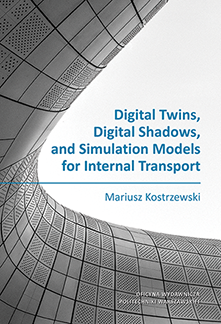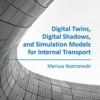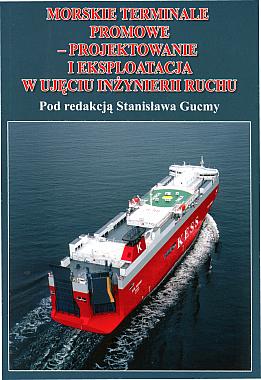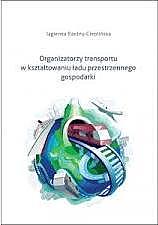Digital Twins, Digital Shadows, and Simulation Models for Internal Transport
Autor: Mariusz Kostrzewski
The ideas presented in this monograph are intended to stimulate imagination and willingness for further research into digital models of various types, including simulation models, numerical models, digital twins, and digital shadows. The monograph itself ought to be treated as a foundation in the fi eld of these models in relation to internal transport and logistics analysis. As such, it can bring several benefi ts
and dispel doubts about the various types of digital models in both the scientific and business communities, especially given the increasing popularity of digital models (including their novel variants, i.e. digital twins and digital shadows).
Given the above brief presentation of the monograph’s contributions, it is important to point out that it is addressed to a wide audience, including managers in industry, manufacturing, transport, and academia – both scientifi c, research, and teaching, as well as Ph.D. students and undergraduates, especially at the technical universities. The book will be a resource for those wishing to expand their knowledge of the applications of innovative technologies related to digital models, particularly digital twins, digital shadow, and simulation models.
Monografia rozpoczyna się od części przeglądowej, która jest wynikiem ostatnich badań i rozważań autora w zakresie obszarów i gałęzi transportu, w tym – w porządku alfabetycznym transportu drogowego, lotniczego, morskiego, przesyłowego, szynowego, wodnego śródlądowego, ale przede wszystkim transportu wewnętrznego z nieodłącznie mu towarzyszącą logistyką wewnętrzną. Zasadniczym celem publikacji jest przedstawienie osiągnięć dotyczących modelowania procesów logistycznych z wykorzystaniem krzywych, w szczególności krzywych Béziera. Krzywe te są stosowane definiowania tras przemieszczania autonomicznych środków transportu wewnętrznego w obiektach logistycznych uwzględniając ich odzwierciedlenie w postaci modeli cyfrowych.
Niniejsza monografia w głównej mierze podejmuje tezy takie jak:
• Terminologia dotycząca cyfrowych bliźniaków może zostać usystematyzowana i wyjaśniona.
• Cyfrowe bliźniaki/cienie/modele charakteryzują się różnymi przeznaczeniami.
• Cyfrowe bliźniaki/cienie/modele charakteryzują się różną architekturą przepływu danych.
• Cyfrowy bliźniaki znacząco przyczyniają się do zużycia energii i emisji ekwiwalentu CO2.
• Krzywe Béziera mogą być stosowane do definiowania tras dla autonomicznych środków transportu wewnętrznego.
• Modelowanie z wykorzystaniem metod symulacyjnych jest metodyką wyjściową do budowania i stosowania modeli cyfrowych, w szczególności cyfrowych bliźniaków i cyfrowych cieni.
TABLE OF CONTENTS
List of Symbols and Abbreviations 9
Introduction 13
1. Nomenclature of Digital Modelling Approaches and Methods 17
1.1. Former State-of-the-Art in Digital Modelling 17
1.2. Modern Approaches to Digital Modelling 25
2. The Origins of Digital Twin and Digital Shadow Technologies 30
2.1. What is Going on with the Digital Twins’ Concept? 30
2.2. Materials and Methods 31
2.3. Equivalence in Terminology: Results and Discussion 36
3. Application of Digital Models in Transport 43
3.1. Positioning of Digital Modelling Design among Research Modelling Methods 43
3.1.1. State-of-the-Art in Digital Modelling across Branches of Transport 43
3.1.2. Applications of Digital Twins in Air Transport 47
3.1.3. Applications of Digital Twins in Maritime and Inland Transport 49
3.1.4. Applications of Digital Twins in Rail Transport 51
3.1.5. Applications of Digital Twins in Road Transport 54
3.1.6. Applications of Digital Shadows in Various Branches of Transport 58
3.1.7. Applications of Simulation Models in Various Branches of Transport 59
3.2. Applications of Digital Twins in Internal Transport 60
3.3. Applications of Simulation Models in Internal Transport 64
3.4. Digital Models of Different Scales 67
4. Representations of Digital Models in Design Practice 71
4.1. Modelling Internal Transport and Logistics Processes Using Mathematical Curve Mo-
dels 71
4.2. Mobile Platform/Robots’ Routes Expressed by the Bézier Curves 79
5. Application of Digital Models in Autonomous Means of Internal Transport 116
5.1. Digital Model: Preparation for Analyses and Investigation 116
5.2. Digital Model: Alternatives and Results 121
5.3. Digital Model: Results Discussion 125
5.4. Comparison of Global Scores for Internal Transport Subsystem – Research Conclu-
sion 129
5.5. Research Limitations 130
6. Discussion on Novel Directions of the Digital Model Concept 132
8
Conclusion 136
Appendices 143
Appendix A. Bézier Curves 143
Appendix B. Curve Length 148
Appendix C. A Brief Classification of Industrial Robots 151
Appendix D. Partial Results of the Digital Model 155
Glossary of Terms and Concepts 162
Bibliography 173
List of Figures 203
List of Tables 205
Abstract 207
Streszczenie (Polish Summary) 209








Opinie
Na razie nie ma opinii o produkcie.